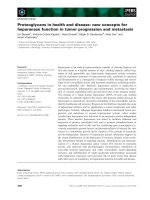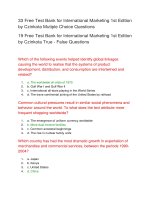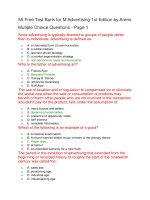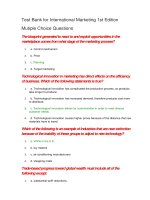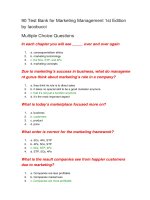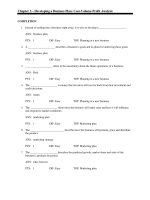Nutrition and you core concepts for good health 1st edition joan salge blake test bank
Bạn đang xem bản rút gọn của tài liệu. Xem và tải ngay bản đầy đủ của tài liệu tại đây (196.09 KB, 8 trang )
TRUE/FALSE. Write 'T' if the statement is true and 'F' if the statement is false.
1) Nutrition knowledge has no influence on our food choices.
Answer:
True
False
1) _______
2) Diet, genes, and physical activity influence your risk for disease.
Answer:
True
False
2) _______
3) Vitamins are inorganic compounds.
Answer:
True
False
3) _______
4) Supplements provide the same health benefit as nutrients and nonnutrients from food.
Answer:
True
False
4) _______
5) A single food can be good for you even if it does not provide all the nutrients.
Answer:
True
False
5) _______
6) The American diet is very healthy.
Answer:
True
False
6) _______
7) Heart disease, kidney disease, and respiratory disease are the three leading causes of death in
the United States and can be prevented through good nutrition.
Answer:
True
False
7) _______
8) Even with all the diet information available to Americans, our body weights are increasing.
Answer:
True
False
8) _______
9) Eleven percent of Americans, suffering from food insecurity, lack enough food to eat daily.
Answer:
True
False
9) _______
10) Rates of obesity are highest in people with the highest incomes.
Answer:
True
False
10) ______
11) The body slows metabolism and hoards calories during periods of hunger.
Answer:
True
False
11) ______
12) Low-cost foods tend to taste better.
Answer:
True
False
12) ______
13) Water helps maintain your body temperature and acts as a lubricant for your joints, eyes, mouth,
and intestinal tract.
Answer:
True
False
13) ______
MATCHING. Choose the item in column 2 that best matches each item in column 1.
Match the term to its definition.
14) DNA
A) the essential nutrients you need in
smaller amounts
Answer: B
15) Nutrition
Answer: F
16)
B) the substance of which genes are made
C) a state of complete physical, mental, and
14) ______
15) ______
social
well-being
Essential
Answer: K
17)
16) ______
D) the part of the plant that isn't digested in
the small intestine
Macronutrients
Answer: J
18)
17) ______
E) substances that speed up reactions in
your body
Micronutrients
Answer: A
19)
18) ______
F) the science that studies how the nutrients
in food affect your health
Enzymes
Answer: E
20)
19) ______
G) processing of genetic information to
create a specific protein
Organic
Answer: I
21)
20) ______
H) carrying an excessive amount of body fat
above the level of being overweight
Fiber
Answer: D
21) ______
I) substances containing carbon
22) Gene expression
Answer: G
23) Health
Answer: C
24) Palatability
Answer: M
25) Hydration
Answer: L
22) ______
J) the energy-containing essential nutrients
you need in higher amounts
23) ______
K) nutrients you must have in order to
function
24) ______
L) maintaining the level of water in the body
for optimum health
25) ______
M) the tendency of food to satisfy our taste
buds
26) Obesity
Answer: H
26) ______
MULTIPLE CHOICE. Choose the one alternative that best completes the statement or answers the question.
27) What role do diet, exercise, and genetics play in our health?
27) ______
A) It depends on our gender and age.
B) They have no effect on our health.
C) They can influence our health for better or worse.
D) none of the above
Answer: C
28) Which type of stress is a major risk factor for ill health?
28) ______
A) mental
Answer: B
B) chronic
C) physical
D) acute
29) A potent predictor of health problems is low socioeconomic status because of
A) the use of alcohol and tobacco to cope with chronic stress.
B) the inability to get to the doctor.
C) the lack of social contact.
D) the possible lack of education.
Answer: A
29) ______
30) Having a good basis of nutrition knowledge will
A) justify a high-protein diet.
B) influence our food choices.
C) encourage us to eliminate carbohydrates from our diet.
D) do all of the above.
Answer: B
30) ______
31) The ________ you inherited from your parents influence(s) the way your body uses food.
A) genes
B) taste buds
C) height
D) digestion
Answer: A
31) ______
32) A chronic deficiency of iron can make you feel
A) short of breath.
B) tired.
32) ______
C) weak.
D) all of the
above.
Answer: D
33) A disease characterized by poor bone density and increased risk of fracture is called
A) osteoporosis.
B) hepatitis.
C) anemia.
D) beriberi.
Answer: A
33) ______
34) Good nutrition plays a role in reducing the risk of all of the following diseases, EXCEPT
A) cancer.
B) stroke.
C) diabetes.
D) kidney disease.
Answer: D
34) ______
35) What does deoxyribonucleic acid (DNA) contain?
A) the instructions cells use to build protein
B) the instructions cells use to break down fats
C) the instructions cells use to absorb nutrients
D) the instructions cells use to metabolize minerals
Answer: A
35) ______
36) The study of the relationship between diet and genes is called
A) dietary genetics.
B) genetic nutrition.
C) the human genome.
D) nutritional genomics.
Answer: D
36) ______
37) What was the collaborative effort to determine and sequence DNA in human cells called?
A) Human Gene Expression Mapping
B) Human Genome Project
C) Human Nutrition Genome
D) Human DNA Sequencing
Answer: B
37) ______
38) Nutritional genomics would be used to determine the best combination of nutrients for an
individual
based on 38)
that
person's
A) eating habits.
C) genetic makeup.
Answer: C
39) The essential nutrients include
A) minerals, fiber, and vitamins.
C) fats, carbohydrates, and fiber.
Answer: B
___
___
B) food likes and dislikes.
D) stress levels.
39) ______
B) carbohydrates, protein, and fats.
D) alcohol, water, and minerals.
40) Which is the correct definition of the term organic?
A) contains nitrogen
B) contains carbon
C) grown in rich soil
D) provides iron
Answer: B
40) ______
41) Which of the following is inorganic?
A) water
B) salts
Answer: D
41) ______
C) minerals
D) all of the above
42) Because you need higher amounts of these in your diet, they are called macronutrients.
A) vitamins
B) phytochemicals
C) carbohydrates
D) minerals
Answer: C
42) ______
43) The energy in food is measured in
A) Celsius.
B) kilograms.
Answer: C
43) ______
C) calories.
D) grams.
44) Which nutrient provides the body with glucose?
A) carbohydrates
B) fats
Answer: A
C) vitamins
D) proteins
44) ______
45) Which nutrient is the body's preferred source of energy?
A) protein
B) minerals
C) carbohydrates
Answer: C
45) ______
D) fiber
46) The body uses protein to
A) maintain body temperature.
B) build and maintain muscles, organs, and tissue.
C) convert minerals to energy.
D) do all of the above.
Answer: B
47) Which nutrient provides the body with energy but is not essential?
A) carbohydrates
B) alcohol
C) protein
Answer: B
46) ______
47) ______
D) fats
48) The best way to ensure that your diet is well balanced is to
A) avoid foods containing fat.
B) eat only packaged foods with food
labels.
C) eat a variety of foods.
D) take supplements.
48) ______
Answer: C
49) Which of the following has the highest carbohydrate content?
A) raw broccoli
B) popcorn
C) chicken with skin
D) they all have about the same
Answer: B
49) ______
50) Foods high in fiber are often good sources of ________.
A) B vitamins
B) protein
C) fats
Answer: D
50) ______
D) phytochemicals
51) Under what conditions would people benefit from taking a supplement?
A) anemia
B) lactose intolerance
C) pregnancy
D) all of the above
Answer: D
51) ______
52) American intake of which two nutrients exceeds the recommended amount?
A) calcium and monounsaturated fat
B) carbohydrates and protein
C) sodium and saturated fat
D) iron and vitamin C
Answer: C
52) ______
53) Americans often fail to meet their needs for these two nutrients.
A) protein and saturated fat
B) sodium and vitamin C
C) vitamin E and calcium
D) none of the above
Answer: C
53) ______
54) Two health problems related to our diet that have become epidemic in the USA are
A) osteoporosis and sleep deficit.
B) overweight and obesity.
C) anemia and lung problems.
D) attention deficit disorder and strokes.
Answer: B
54) ______
55) What percentage of the adult American population is currently overweight?
A) over 65 percent
B) over 55 percent
C) over 35 percent
D) over 75 percent
Answer: A
55) ______
56) Which of the following is one of the two main goals for Healthy People 2010?
A) to help Americans reduce their stress
B) to help Americans better understand MyPyramid
C) to help Americans increase their life expectancy
D) to help Americans increase their intake of animal products
Answer: C
56) ______
57) Which nutrient aids in enzyme function?
A) fats
B) protein
Answer: C
57) ______
C) vitamins
D) water
58) When you carry extra weight on your body in relation to your height, you are considered
A) just right.
B) pleasantly plump.
C) obese.
D) overweight.
Answer: D
58) ______
59) The diet-related number-one cause of death in the United States is
59) ______
A) stroke.
Answer: B
B) heart disease.
C) diabetes.
60) Which foods are more likely to satisfy our taste buds?
A) cookies
B) chicken
C) carrots
Answer: A
D) kidney disease.
60) ______
D) apples
ESSAY. Write your answer in the space provided or on a separate sheet of paper.
61) What is the difference between a macronutrient and a micronutrient?
Answer: A macronutrient is needed in larger quantities than a micronutrient. Vitamins and minerals are
micronutrients, and the energy nutrients (carbohydrates, fats, and proteins) are macronutrients.
62) What are the essential nutrients and why do you need them?
Answer: The essential nutrients are carbohydrates, fats, proteins, vitamins, minerals, and water. They are all
equally important to the body because they work together to support growth and reproduction, to
supply energy, and to help repair and maintain the body. The body cannot make these essential
nutrients and thus they must come from the diet.
63) Poor people have less money to buy food yet obesity is highest among people with the lowest income.
Explain.
Answer: Foods with the lowest cost tend to be high in fat and sugar, high in calories, and low in essential
nutrients. People lacking money are forced to buy cheap food. The result is a diet abundant in calories,
resulting in weight gain while leaving the individual malnourished.
1)
2)
3)
4)
5)
6)
7)
8)
9)
10)
11)
12)
13)
14)
15)
16)
17)
18)
19)
20)
21)
22)
23)
24)
25)
26)
27)
28)
29)
30)
31)
32)
33)
34)
35)
36)
37)
38)
39)
40)
41)
42)
43)
44)
45)
46)
47)
48)
49)
50)
51)
FALSE
TRUE
FALSE
TRUE
TRUE
FALSE
FALSE
TRUE
TRUE
FALSE
TRUE
TRUE
TRUE
B
F
K
J
A
E
I
D
G
C
M
L
H
C
B
A
B
A
D
A
D
A
D
B
C
B
B
D
C
C
A
C
B
B
C
B
D
D
52)
53)
54)
55)
56)
57)
58)
59)
60)
61)
C
C
B
A
C
C
D
B
A
A macronutrient is needed in larger quantities than a micronutrient. Vitamins and minerals are micronutrients, and
the energy nutrients (carbohydrates, fats, and proteins) are macronutrients.
62) The essential nutrients are carbohydrates, fats, proteins, vitamins, minerals, and water. They are all equally
important to the body because they work together to support growth and reproduction, to supply energy, and to
help repair and maintain the body. The body cannot make these essential nutrients and thus they must come from
the diet.
63) Foods with the lowest cost tend to be high in fat and sugar, high in calories, and low in essential nutrients. People
lacking money are forced to buy cheap food. The result is a diet abundant in calories, resulting in weight gain while
leaving the individual malnourished.

